

Whenever a player marches one or more of his units into an area containing units from another House, combat ensues.
Combat is resolved by comparing the total Combat Strength of the battling sides. The victor is the player who gathers the highest Combat Strength.
The following elements can contribute to Combat Strength:
- Units in the combat
- Supporting units
- Defense Order (defender only)
- March Order (attacker only)
- The Valyrian Steel Blade token
- House cards
- Garrison token (defender only)
The player resolving the March Order is considered the attacker (and his units are attacking) while the opponent occupying the contested area is the defender (and his units are defending).
Any supporting units (via a Support Order from an adjacent area) are considered supporting (i.e., they are not considered attacking or defending).
Combat is resolved by performing the following steps:
- Call for Support
- Calculate Initial Combat Strength
- Choose and Reveal House Cards
- Use Valyrian Steel Blade
- Calculate Final Combat Strength
- Combat Resolution
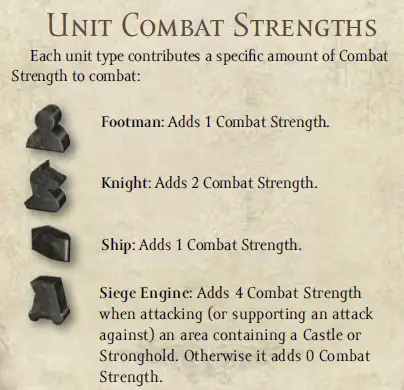

I. Call for Support
During the first step of combat, both attacker and defender may plead for support from all areas adjacent to the embattled area that contain a Support Order.
A player who controls such an adjacent Support order may now grant (or refuse to grant) his supporting Combat Strength to either the attacker or the defender.
Supporting Combat Strength means the combined Combat Strength of all units in the supporting area. Support may be given to any adjacent combat, whether a supporting player's own forces are in the combat, or the combat is between two other players.
If there are multiple Support Orders adjacent to the embattled area, support must be declared (or refused) in turn order. If the attacking or defending player has friendly Support Orders in adjacent areas, he may support himself in the combat (and usually will do so).
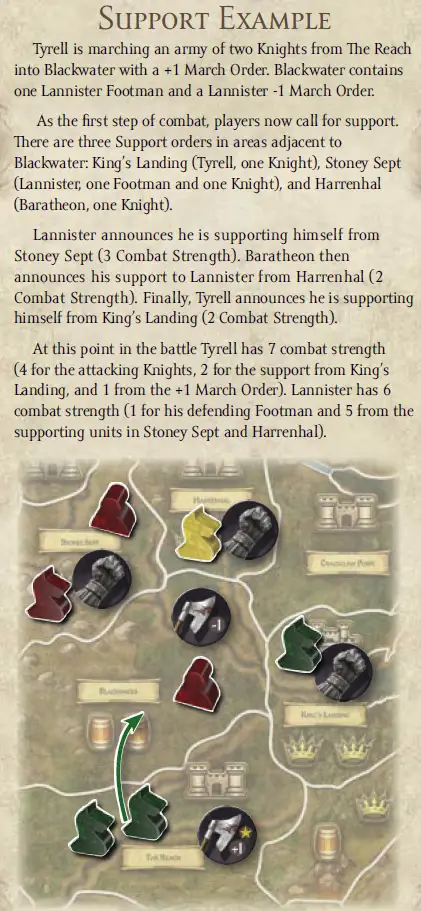
Other Rules for Support Orders:
When a player grants support, his Support Order token is not removed after the combat. A Support Order may support any number of adjacent combats in the same game round.
A Support Order gives no defensive benefit to attacks against its own area (the units in its area will defend normally).
Attacking or defending players may refuse support.
Ship units may support adjacent combat in a sea area or a land area. Footmen, Knights, or Siege Engine units, however, may never provide support to combat in a sea area.
Supporting Siege Engine units only provide supporting Combat Strength when supporting the attacker in an embattled area containing either a Castle or Stronghold.
A supporting player must contribute an area's full supporting Combat Strength, or none at all.
A player may never support an opponent in combat against his own units.
Reminder: Support can be granted only from an area containing a Support Order that is adjacent to the embattled area. Do not confuse the embattled area with the area the attacking March Order was assigned to (and from which the attackers marched).
After all Support Orders adjacent to the embattled area have granted (or refused) support, proceed to the next Combat step.

II. Calculate Initial Combat Strength
Both sides now tally and announce their Combat Strength.
This number is referred to as their Initial Combat Strength. It includes all Combat Strength bestowed from the following sources:
- Attacking/defending units
- Defense order bonus (for the defender only)
- March order bonus/penalty (for the attacker only)
- Supporting units and Special Support Order bonuses
- Garrison token
Both players clearly announce their initial Combat Strength after which the combat proceeds to the "Choose and Reveal House Cards" step.

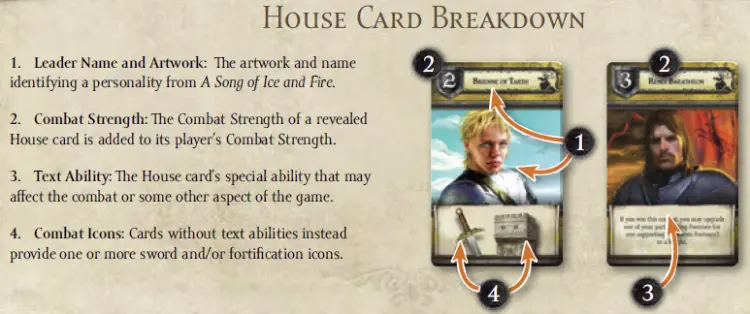
III. Choose and Reveal House Cards
Both attacker and defender now secretly select one House card from their hands of House cards. When both players are ready, the two cards are simultaneously revealed and any text abilities of the cards are resolved.
Playing a House card during combat is mandatory. Both attacker and defender must play a card. Combat then proceeds to step 4 "Use Valyrian Steel Blade".
The House Cards
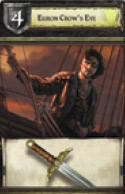
Each player begins the game with seven unique House cards. These represent characters lending their abilities and strength to combat.
After players reveal House cards during a combat, the text abilities of the two House cards are immediately resolved. Some text abilities specify that they are implemented later during the same combat (such as "at the end of the combat") but unless stated otherwise, implement the effect immediately.
There are instances when the exact order of House card resolution is important. Should a timing conflict occur, follow this order of operations:
Any "Ignore" or "Cancel" text abilities are first resolved in the player order of the Iron Throne track.
Other conflicting text abilities are then resolved in the player order of the Iron Throne track.
After the outcome of combat is determined, any "win/lose this combat..". text abilities are resolved in the player order of the Iron Throne track.
The text ability of the first card is implemented completely before that of the second card.
After a combat is resolved, the two played House cards are placed face-up in their respective player's discard pile. While a House card is in a player's discard pile, it is not available for use in combat.
At the end of a combat, if a player used his last (i.e., seventh) House card, he then returns the other six House cards currently in his discard pile to his hand. The last played card remains in the discard pile.
The Combat Icons
Some cards do not have a text ability, instead they provide their player with one or more combat icons. There are two combat icons in A Game of Thrones: The Board Game: The Sword icon and the Fortification icon.

The Sword Icon: During the "Combat Resolution" step, the player who won the combat (i.e., the victor) counts the number of Sword icons on his House card. For each Sword icon, an enemy unit in the embattled area must be destroyed.

The Fortification Icon: For each Fortification icon on the House card of the defeated player, one of the victor's Sword icons is ignored.
Note: All House cards, whether available or used (i.e., discarded), are public knowledge. As such, a player's discard pile or hand may be examined by others players at any time except during Step 3 of combat.

IV. Use Valyrian Steel Blade

If either the attacker or the defender holds the Valyrian Steel Blade token, that player now has the option of using its ability to provide +1 to his total Combat Strength. If used, flip the token to its faded side, as a reminder that it cannot be used again this round.

V. Calculate Final Combat Strength
Both sides now combine their initial Combat Strength with any modifiers accumulated by playing House cards and using the Valyrian Steel Blade token. This final value is referred to as a player's Final Combat Strength.
Below is a summary of what could contribute to each player's final Combat Strength:
- Initial Combat Strength *
- The Combat Strength and applicable text abilities of the chosen House card
- The Valyrian Steel Blade's +1 Combat Strength (if available and used)
* Some House card text abilities may cause a player's initial Combat Strength to be recalculated. For example, if the text of a revealed House card destroys an opponent's Footman unit, the initial Combat Strength of that opponent is reduced by 1 during this step.

VI. Combat Resolution
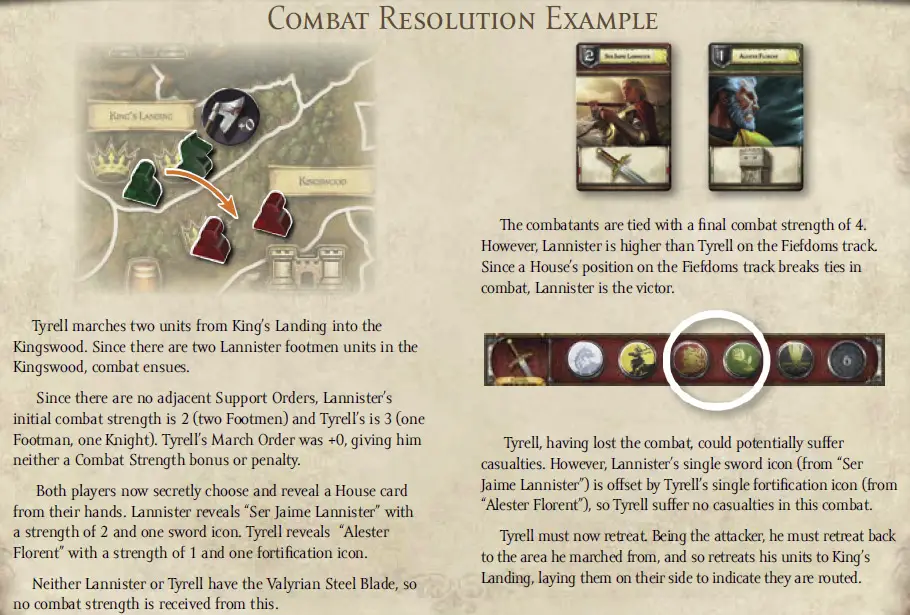
The combat is concluded by performing the following steps:
1. Determine Victor
The player with the highest final Combat Strength wins the combat and his opponent is defeated. If the final Combat Strength results are tied, the player with the higher position (i.e., closer to the "1" position) on the Fiefdoms track wins the combat.
2. Casualties
Only the defeated player takes casualties in combat. Casualties are determined as follows:
- Victor's Sword Icon: Count the number of Swords icons on the victor's House card.
- Defeated Player's Fortification Icons: Count the number of Fortification icons on the defeated player's House card.
- Defeated Player Suffers Casualties: The defeated player must destroy one unit in the embattled area for each Sword icon of the victorious player minus the number of Fortification icons of the defeated player (if the result is zero or less, the defender takes no casualties).
When a player suffers casualties, he decides which of his units are removed (unless stated otherwise by the text ability of a played House card). Remember that supporting units can never be taken as casualties in combat.
Note: Each casualty suffered destroys a single unit, regardless of Combat Strength. In other words, removing a Knight unit as a casualty still counts as only one casualty even though its Combat Strength is 2. For this reason, it is generally best to remove Footmen units as casualties, if able.
3. Retreats and Routing
After suffering casualties, the losing army must retreat from the embattled area (supporting units do not retreat).
If the attacker lost the combat, his surviving units must retreat back to the area from which they marched.
If the defender lost the combat, his surviving units must retreat using the following rules:
The retreating units must retreat to one empty adjacent area (i.e., one containing no enemy units or enemy Power tokens) or to a friendly area (i.e., one containing friendly units, and/or a friendly Power token).
The retreating units must retreat to the same area.
The retreating units may never retreat to the area the attacking units marched from, even if it is empty.
A player may not retreat his defending units to an area containing friendly units if this would cause him to exceed his Supply limit. If a player's only option is to retreat to such an area, he must first destroy as many retreating units as necessary to be compliant with his Supply limit after retreating to the area. After taking such losses, he may retreat the remaining units.
If there is no legal area in which to retreat, all retreating units are destroyed.
Footmen or Knight units may not retreat to a sea area or a port. Ship units may never retreat to a land area.
After retreating, all retreated units are placed on their sides to signify they are now routed. Routed units provide no Combat Strength, but still count towards a player's supply limit.
If a routed unit is forced to retreat, it is instead destroyed. Routed units may never be chosen as casualties in combat and may not move, even if a March Order token is resolved in their new area.
player is allowed to use ship transport to retreat his units.
Siege Engine units cannot retreat. If a Siege Engine unit is forced to retreat, it is instead destroyed.
4. Combat Clean Up
After combat is completed, remove the attacking player's March Order token from the game board.
If the combat was won by the attacker, remove any Order token the defender had assigned to the embattled area (if one remains) as well as any Power token in the area (which would exist if the defending player had previously established control there).
If the combat was won by the defender, the defending player's Power and Order tokens (if any) in the area are unaffected.
Both played House cards are discarded to their respective player's discard piles, and the "Resolve March Orders" step of the Action Phase now continues.
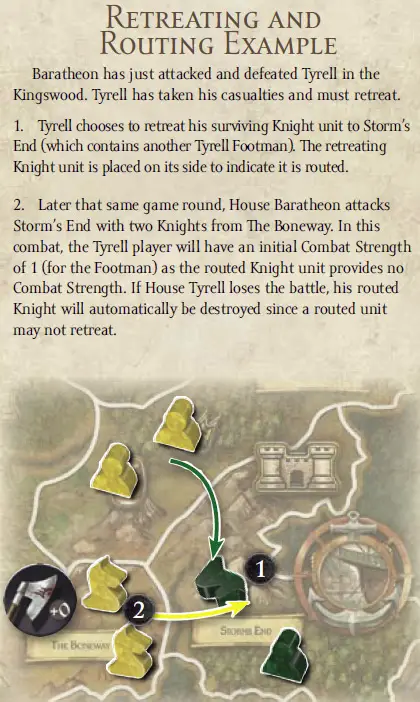
Continue Reading

